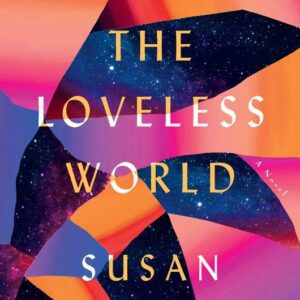“Against the Loveless World” tells a story of exile through the eyes of Nahr, a Palestinian refugee. Susan Abulhawa’s novel transports the reader across country borders and through political turmoil, depicting landmark events through a lens beyond conventional statistics. Abulhawa breathes life into the defining moments of contention between Israel and countries across the Arab world. She details the life of Nahr, capturing her grievances alongside the mundane and playful aspirations she clung to through the horrors. Born in Hawalli, a Palestinian-majority neighborhood in Kuwait, during the 1970s, the novel’s protagonist yearned for the fairytale ending: a prince charming who would sweep her off her feet, loving children, and a home. After enduring a failed marriage, a poverty-stricken family life, and a consequent career in sex work, Nahr does live out her romantic fantasies, although distinctly untraditional from the cliches.
Nahr’s story begins in the “Cube.” After years of persuading prison guards, the novel’s protagonist secured pencils and a notebook. She sat, confined within nine square meters of the Israeli prison’s cinder-block walls, and utilized her newly acquired gifts to document her story. She vowed to “tell it as storytellers do,” detailing every emotion and sentiment (p. 10). Nahr starts by capturing her devotion to Eastern dance—also known as “belly dancing”—the ultimate pillar of her belief system. She praised its “chaos and anarchy” and ability to relinquish rule and hierarchy (p. 11). Migrating from Kuwait, Jordan, Palestine, Jordan, and Palestine again, Eastern dance offered her a glimpse of liberation in a life of persistent exile. She illustrated the messy, complex, yet affectionate relationship she shared with her mom, brother, and grandmother—a family grieving the unexpected loss of her father, the family patriarch. Nahr articulated her shatterproof bond to the land. As she longed for the Kuwaiti beaches’ salty air and Palestine’s hills ridden with poppies and olive groves, Nahr’s loyalties extend to her birthplace and ancestral home. Most of all, she yearned for Bilal, who introduced Nahr to a concealed world of organized resistance amid a wholesome, unanticipated romance.
Although born to a family of Palestinian refugees, Nahr felt alienated from her ancestral ties as a child in Kuwait. She devoted her youth to her newfound homeland, admiring their “delicate Khaleeji thobes…diwaniyas…and tribal ways” (p. 22). At seventeen, Nahr married a 25-year-old Palestinian “bona fide hero” (p. 25). Their eventual divorce led her to Um Buraq, who introduced Nahr to a lucrative career in sex work. However, Nahr and her family soon fled to Jordan following Saddam Hussein’s invasion of Kuwait. Residing in a congested one-bedroom apartment in Amman, Nahr endured the trauma of forced displacement familiar to her mother and grandma. She, at last, returned to Palestine to finalize her divorce, releasing her pent-up admiration for the motherland. She meets her former brother-in-law, Bilal, and the two endure a tragic romance through arrests, military lockdowns, and an elaborate operation.
In her renowned novel, Abulhawa weaves reality with fiction, although the fabricated events are not that far-fetched. She reveals Kuwait’s sex work industry, hidden from mainstream historical narratives. She tackles Saddam Hussein’s invasion of Kuwait in 1990, which expelled tens of thousands of Palestinian refugees from Kuwait. The Gulf War coerced some, like Nahr, to abandon their newly built lives in Kuwait and migrate once again to Jordan, where they resided in impoverished, overpopulated neighborhoods. Abulhawa delves into the Second Intifada, a stream of Palestinian-led protests against Israel in 2000. She details Israeli military tactics, including a curfew that restricted Palestinians to their homes for weeks, a persistent arrest campaign, and the expansion of Israeli settlements. Abulhawa provides a peek into the mundane lives of the victims of some of the most disputed events in recent history. She develops characters that capture bits and pieces of the diverse lives of Palestinians, exemplifying resilience and community.
The title of “Against the Loveless World” is a nod to the words of African American writer James Baldwin. In a letter to his nephew, he communicates: “Here you were: to be loved…to strengthen you against the loveless world” (p. 298). The novel follows Nahr as she attempts to find love in a reality that denounces anything like it. And she does. As the protagonist articulates, “despite everything, [she] was loved… At once and forever against the loveless world” (p. 298). She clings to and treasures this love she holds for her family, friends, dance, and Bilal. It is what strengthens her through the years in the Cube. While the reader is not ignorant of Nahr’s eventual fate, Abulhawa cultivates a storyline that sparks hope within the reader. Whether it is hope for a different ending or an altogether different reality free of grievances, “Against the Loveless World” kindles a fiery awareness that leaves the reader desperately rereading through past pages in search of hidden answers or missed details obscured in Abulhawa’s lyrical prose.
Discussion questions:
- How did the novel challenge your outlook on the experiences of refugees? How did it challenge your outlook on the reality of Palestinians?
- Throughout the novel, Nahr yearns for love. How does Susan Abulhaw illustrate unconventional forms of love in “Against the Loveless World”?
- A quote by James Baldwin inspired the title of the novel. What significance do the works of an African American civil rights activist add to the story of a Palestinian refugee? What do you think Susan Abulhawa was trying to convey?
- Why do you think Abulhawa chose to begin a novel on exile and displacement in a prison cell?


